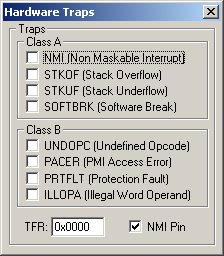|
||
| Products Download Events Support Videos | ||
Product Information
Device Database®
Downloads
Compliance Testing
Distributors
Peripheral Simulation
For Infineon XC164SM-8F — NMI
Simulation support for this peripheral or feature is comprised of:
- Dialog boxes which display and allow you to change peripheral configuration.
- VTREGs (Virtual Target Registers) which support I/O with the peripheral.
These simulation capabilities are described below.
Hardware Traps Dialog

The Hardware Traps dialog shows the status of all the supported hardware traps. The configuration of these traps is displayed and may be changed using the appropriate control.
Class A
- NMI (Non Maskable Interrupt) is set to indicate a falling edge is detected on the NMI pin.
- STKOF (Stack Overflow) is set to indicate a the current stack pointer is less than the value of the STKOV register.
- STKUF (Stack Underflow) is set to indicate a the current stack pointer is greater than the value of the STKUN register.
- SOFTBRK (Software Break) is set when a software break event is detected.
Class B
- UNDOPC (Undefined Opcode) is set to indicate the current instruction is not a valid XC164 opcode.
- PACER (PMI Access Error) is set when an illegal attempt to access program memory is detected.
- PRTFLT (Protection Fault) is set when a protected instruction with an illegal format is detected.
- ILLOPA (Illegal Word Operand) is set when the MCU attempts to read or write to an odd address.
Traps
- TFR (Trap Flag Register) contains the combined trap flags settings described above.
- NMI Pin allows you to change or view the state of the external Non Maskable Interrupt pin.
NMIPIN VTREG
Data Type: unsigned char
THE NMIPIN VTREG contains the state of the NMI pin on the simulated MCU. Normally, the NMI pin is high (indicating that there is no non-maskable interrupt condition). NMI goes low to signal a non-maskable interrupt. Enter the following in the Command window to trigger an NMI Trap using the NMIPIN VTREG.
NMIPIN=0
Enter the following to return the NMI pin to a high level.
NMIPIN=1
Note that on some devices the NMI pin must be low to enter Power Down Mode.
ProductsDevelopment Tools |
Hardware & Collateral |
Downloads |
Support |
Contact |
